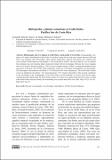| dc.contributor.author | Rincón - Alejos, Fernando | |
| dc.contributor.author | Ballestero Sakson, Daniel | |
| dc.date.accessioned | 2020-08-05T18:58:32Z | |
| dc.date.available | 2020-08-05T18:58:32Z | |
| dc.date.issued | 2015-07 | |
| dc.identifier.issn | 00347744 | |
| dc.identifier.uri | http://hdl.handle.net/11056/17827 | |
| dc.description.abstract | Oceanographic variables at 33 stations distributed in Golfo Dulce, Costa Rica, during the dry and rainy seasons between 2009 and 2010, were analyzed with CTD profiles, where salinity, temperature, sigma-T and currents were studied in the water column. Secchi depth and chlorophyll_α were measured in surface. The main objective was to estimate the catchment area and estuarine plume dispersion formed with river discharge. Between the rivers Esquinas and Coto Colorado, decreased salinity (<30) in an area of approximately 250km2, creating thermohaline fronts along most of the gulf. The El Niño South Oscillation, which was in the phase of heightened was documented. The chlorophyll concentrations correlated 33.7% with Secchi disc water transparency. The Golfo Dulce surface water was identified with salinity <31.5 and temperature >27°C (April to December). This research contributes to the knowledge of the oceanography of the Golfo Dulce and the feedback we receive from fluvial origin, claiming form providing inputs for the potential creation of a major new marine protected area system covering entire Golfo Dulce area and, ideally, the surrounding river systems that feed it. © 2015, Universidad de Costa Rica. | es_ES |
| dc.description.abstract | Las variables oceanográficas en 33 estaciones distribuidas en el Golfo Dulce, Costa Rica, durante las estaciones seca y lluviosa entre 2009 y 2010, se analizaron con perfiles CTD, donde se estudiaron la salinidad, temperatura, sigma-T y corrientes en la columna de agua. La profundidad de Secchi y la clorofila_a se midieron en superficie. El objetivo principal era estimar el área de captación y la dispersión de la columna de estuario formada con la descarga del río. Entre los ríos Esquinas y Coto Colorado, la salinidad disminuyó (<30) en un área de aproximadamente 250 km2, creando frentes termohalinos a lo largo de la mayor parte del golfo. La Oscilación del Sur de El Niño, que estaba en la fase de aumento, fue documentada. Las concentraciones de clorofila correlacionaron 33.7% con la transparencia del agua del disco Secchi. El agua superficial del Golfo Dulce se identificó con salinidad <31.5 y temperatura> 27 ° C (abril a diciembre). Esta investigación contribuye al conocimiento de la oceanografía del Golfo Dulce y la retroalimentación que recibimos del origen fluvial, reclamando un formulario que proporciona insumos para la posible creación de un nuevo sistema de áreas protegidas marinas que cubre todo el área del Golfo Dulce e, idealmente, el río circundante sistemas que lo alimentan. | es_ES |
| dc.description.sponsorship | Universidad Nacional, Costa Rica | es_ES |
| dc.language.iso | spa | es_ES |
| dc.publisher | Universidad de Costa Rica | es_ES |
| dc.rights | Acceso abierto | es_ES |
| dc.source | Revista de Biología Tropical vol.63 no.2 161-181 2015 | es_ES |
| dc.subject | OCEONOGRAFÍA | es_ES |
| dc.subject | FÍSICA | es_ES |
| dc.subject | GOLFO DULCE (PUNTARENAS) | es_ES |
| dc.subject | RIVER DISCHARGE | es_ES |
| dc.subject | CHLOROPHYLL-A | es_ES |
| dc.subject | EL NIÑO SOUTH OSCILLATION | es_ES |
| dc.title | Hidrography and river plumes in Golfo Dulce, South Pacific of Costa Rica | es_ES |
| dc.title.alternative | Hidrografía y plumas estuarinas en Golfo Dulce, Pacífico Sur de Costa Rica | es_ES |
| dc.type | http://purl.org/coar/resource_type/c_6501 | es_ES |
| dc.description.procedence | Departamento de Física | es_ES |
| dc.identifier.doi | 10.15517/rbt.v63i1.23101 | |

